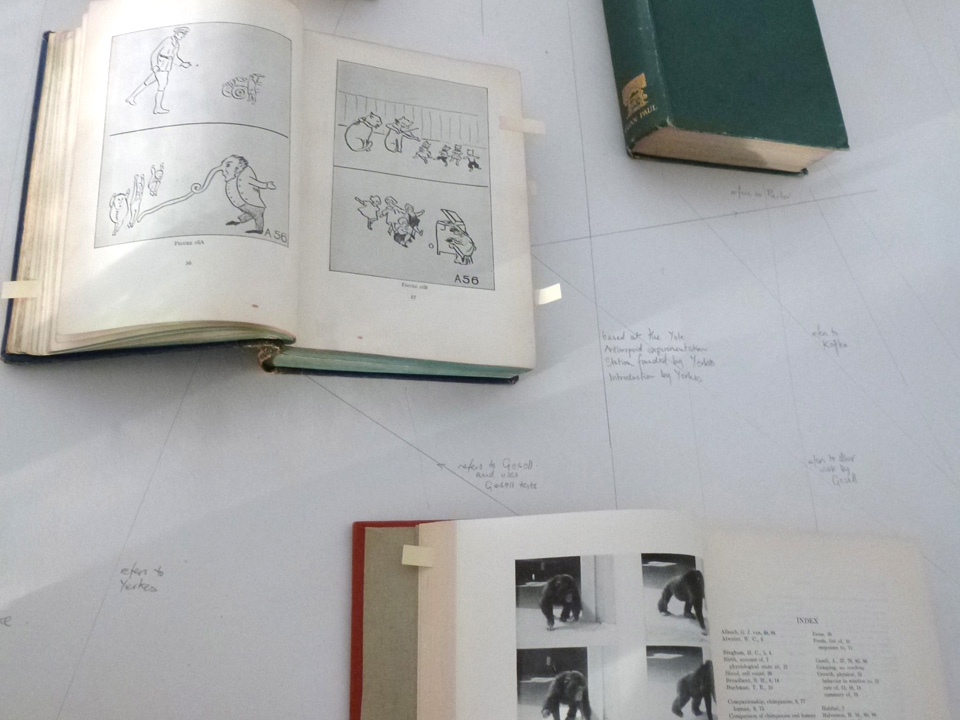Collecting
I began to buy outdated psychology books from online booksellers. The publications date from around 1900 to 1960 and are not classed as rare or antique, they are just unwanted stock. Most still carry the labels and catalogue numbers of the libraries that discarded them. Many of the title pages are stamped ‘withdrawn’, marking a point at which the knowledge inside them became an embarrassment, or at least an irrelevance, and they were consigned to storage until the development of online second-hand bookstores provided a means of disposal.
The first books in my ad hoc collection had a direct connection to Alpha’s story; they were listed as references in the report of Schiller’s drawing experiment (1951). Kurt Koffka’s The Growth of the Mind (1925), an influential European text on gestalt psychology and learning theories, was my first purchases (two copies by mistake). Klüver’s Behavior Mechanisms in Monkeys (1933) was a slightly more obscure acquisition. It details elaborate experimental setups in which captive monkeys are presented with a variety of puzzling situations to test discrimination. The animal’s state of hunger is a prerequisite, and food is placed ingeniously out of reach by the scientists. The book features a capuchin monkey named P-Y. One of the most innovative in creating makeshift tools to ‘pull in’ food items, she was also noted for spontaneously scratching marks on the floor of the experiment room at times of maximum frustration. When finally given paper and crayons, P-Y made a number of drawings: her fine curving lines appear as light ethereal traces emerging from a darker ground in one of the photographic plates.
The list also included Arnold Gesell’s The Mental Growth of the Pre-School Child (1925), which outlines a series of tests devised at the Yale Psycho-Clinic in the 1920s to measure child development and identify ‘defective’ infants. The tests require an array of idiosyncratic objects and picture cards. In Test M40, known as the ‘scribble test’ (or sometimes the ‘writing test’) the child is shown how to scribble with a red crayon. A nine-month-old who could imitate the action would gain an A rating. More difficult drawing tasks for older children follow, such as copying a circle and completing the figure of a man: ‘Drawing should be systematically utilized as a developmental test, if for no other reason than the fact that it leaves its own objective record. […] It may be nothing more than a banging staccato or a faint fugitive scrawl but it belongs to the record’ (Gesell, 1925, p. 83).
As an infant, Alpha was assessed using the Gesell tests in her first year in order to compare her development with that of a human child. Her performance in the scribble test was disappointing: ‘Alpha grasped and brought the crayon to her mouth’, and in later tests ‘Complex drawings, were failed’. The latter observations are recorded in a particularly significant publication that I collected, Development of an Infant Chimpanzee during her First Year (Jacobsen, Jacobsen, & Yoshioka, 1932, p. 85), a scientific monograph bound with others into a large red volume, which arrived carefully packaged from the United States. It comprises eighty pages of charts, tables, and behavioural descriptions of Alpha’s development in infancy, indicating the intense scrutiny she received. Touching the thin, fragile pages and studying the photographs of Alpha intensified my involvement in the story of this long-dead ape.
But it did not stop there. The trail of bibliographic reference led to other works of comparative psychology, psychobiology, behaviourism, and gestalt psychology, mostly dating from the early part of the twentieth century. In retrospect I see the process of collecting as my way of fumbling around an unfamiliar territory. I struggled to understand the psychological discourses that position human beings on the same biological continuum as other species and yet make clear-cut distinction between human and animal at the level of experimental practice. In attempting to understand the ambivalence that I perceived in attitudes toward test subjects such as Alpha (see Introduction), there was no prescribed route.
Alpha was born and raised as part of a breeding programme devised by Robert M. Yerkes, whose publication Chimpanzees: A Laboratory Colony (1943) was another important purchase. Yerkes was a significant figure in the history of comparative psychology and began his colony of chimpanzees in the 1920s as a standardised resource for the scientific community. Purpose-bred apes would stand in for human bodies and minds in a range of psychological, sociological, neurological, and pharmaceutical test situations. Yerkes justified use of other species on grounds of human evolutionary superiority and the paramount goal of scientific knowledge. Donna Haraway (1991, 1989) has examined the writings of Yerkes and shown that his scientific project served governmental and corporate interests at a time of expanding industrialisation and capitalism in the United States. Behavioural research on chimpanzees aimed to demonstrate the biological bases of dominance, competition, and cooperation, thus providing the knowledge necessary to rationalise family and working life toward a more compliant, healthy, and productive population.
In Primate Visions (1989), Haraway displays one method of dealing with the history of science: a politically situated, feminist analysis of the way in which discourses intersect and power relations are played out in primatology over the course of the twentieth century (biological determinism, anthropocentrism, and post-colonialism are just some of the issues this raises). In the light of such analysis, which is based on extensive archival study, what does an idiosyncratic practice of collecting have to offer as a method of research? How can it produce statements or assertions that have any authority?
One answer is to state from the outset that there is no intention to be authoritative. I have not set out to survey or categorise the key texts of twentieth-century comparative psychology. Although I have attempted a more conventional critique of some of the texts elsewhere (MacDonald, 2014), particularly of the Jacobsens’ report on Alpha’s early years, this is directly informed by my sensory engagement with the books as physical objects of knowledge. I am interested in the discipline’s material remains and the graphic traces of Alpha found within them, whether in the form of tabularised data, photographic images, or references in the text. I do not see word configurations as abstract entities that have the same meaning and impact wherever they are reproduced, but as meaningful marks, situated on specific pages. The deposits of ink referring to Alpha are the graphical record of her life, encountered by looking at, and touching, the objects in which they appear. They do not provide direct access of course, but are multiple stages removed by processes of reporting, copying, printing and reproduction. I know that I will never really track Alpha down; but given my geographical and historical distance, the books provide a way to get closer, a tangible link to the period in question.
The books that I gathered are fading and discolouring, their pages are becoming brittle, but they present to me extraordinary visions. For example, there are a striking number of diagrams that show apparatuses such as mazes and puzzle boxes in which small animals could be observed in their efforts to obtain food or avoid electric shocks. I am impressed by the power to make such diagrams and thereby enact a geometry in which the experimenter observes from overhead while the test subject is held perplexed within an elaborately constructed, miniature environment. Captured within the close-set text are descriptions of outlandish procedures and convoluted testing scenarios. Artistic research has the capacity to make strange these demonstrations, to bring into question the knowledge they deliver to other disciplines (for example, theories of perceptual psychology that have influenced artists and philosophers), and to delve into their subconscious baggage. An objective of artistic research might be to probe further into the mechanics of conflicting values and divided subjectivities – for example, those exhibited in the dual relationships between companion animal/test subject and human caretaker/observer.
Ron Broglio, in his recent publication Surface Encounters (Broglio, 2011) notes that artists are keenly aware of surfaces. ‘Artists negotiate the optical and material surfaces presented to them in the world and the surfaces of their materials of expression. The allusive and illusive surfaces form a language – both material and cultural – for artistic expression. It is not a formal language and syntax but a comportment and a way of proceeding’ (Broglio, 2011, p. xvii). One can easily see how the activity of drawing might fit into this description. He argues that this sensory level of engagement allows a particular access to understanding other animals’ worlds because encounters with other species happen at the meeting point of such surfaces. By operating at this level, artists are able to test the limits of established knowledge and push thought in new directions. Although my investigations did not involve a direct encounter with another animal, my approach in gathering this collection of books was to rub up against the surface of the disciplinary knowledge that it represented – reading, but also looking and touching, and preparing to draw from it.
In 2004, Hal Foster wrote of ‘An Archival Impulse’ in contemporary art. Among the artists he cites (for example, Tacita Dean and Thomas Hirschhorn) are those who seek out the remains of past knowledge, generating private collections from forgotten artefacts and recreating fictional narratives from submerged but documented facts. Implicit in such practices is the desire to question or subvert systems of knowledge and to posit alternative means of ordering and connecting. According to Foster, ‘this is not a will to totalize so much as a will to relate – to probe a misplaced past, to collate its different signs (sometimes pragmatically, sometimes parodistically), to ascertain what might remain for the present’ (Foster, 2004, p. 21). The verbs Foster uses – ‘to probe’, ‘to collate’, and ‘to ascertain’ – are all suggestive of research.
Considering my own impulse to collect, I find that, like Foster’s artists, I am ‘concerned less with absolute origins than with obscure traces’ (Foster, 2004, p. 5). There is a textual rationale for many of my choices; the books I have amassed are all connected through footnotes and references to the central figure of Alpha. Collecting has been in part a biographical process of reconnecting her life history. However, some of the chains of reference run laterally and at tangents to her particular story. Rather than straight lines I find I have taken doglegs and sidesteps. The ‘obscure traces’ I am retrieving are not only Alpha’s but also those of a multitude of animals in laboratories, whose experiences did not count as valid data but whose records of life are somewhere locked within the typeset accounts of method and the rectilinear diagrams of apparatuses. Having probed the aging textbooks of psychology for indications of conflicting attitudes, I am in a better position to ‘collate its different signs’ with the traces of its animal test subjects and so ascertain its legacy, not only for the present but also for the future of the heavily fortified border between human and animal.
The positivism of the proofs and findings in the scientific texts that I gathered is displaced by the motivations of artistic research. Their co-option into an artist’s collection – to be viewed as objects of tactile interest and visual examination, a library of curiosities – repositions the truth claims within their fragile pages. They appear as tatty, fading relics, throwing their statements into historical relief. Having collected these books, I redeployed them in my residency at MEANTIME (see ‘Experimenting’): first, I entered into this material at a visual level, by drawing from it (literally); second, I cut into one of the books and made a space inside it that could potentially be occupied by other animals; third, I treated the books as markers in a knowledge field by laying them out in a space that I and others could encounter, walk around, and discuss.



